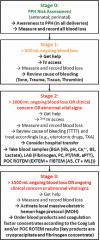Patient blood management in India - Review of current practices and feasibility of applying appropriate standard of care guidelines. A position paper by an interdisciplinary expert group
- PMID: 34103816
- PMCID: PMC8174427
- DOI: 10.4103/joacp.JOACP_410_20
Patient blood management in India - Review of current practices and feasibility of applying appropriate standard of care guidelines. A position paper by an interdisciplinary expert group
Abstract
In a developing country like India, with limited resources and access to healthcare facilities, dealing with massive hemorrhage is a major challenge. This challenge gets compounded by pre-existing anemia, hemostatic disorders, and logistic issues of timely transfer of such patients from peripheral hospitals to centers with adequate resources and management expertise. Despite the awareness amongst healthcare providers regarding management modalities of bleeding patients, no uniform Patient Blood Management (PBM) or perioperative bleeding management protocols have been implemented in India, yet. In light of this, an interdisciplinary expert group came together, comprising of experts working in transfusion medicine, hematology, obstetrics, anesthesiology and intensive care, to review current practices in management of bleeding in Indian healthcare institutions and evaluating the feasibility of implementing uniform PBM guidelines. The specific intent was to perform a gap analysis between the ideal and the current status in terms of practices and resources. The expert group identified interdisciplinary education in PBM and bleeding management, bleeding history, viscoelastic and platelet function testing, and the implementation of validated, setting-specific bleeding management protocols (algorithms) as important tools in PBM and perioperative bleeding management. Here, trauma, major surgery, postpartum hemorrhage, cardiac and liver surgery are the most common clinical settings associated with massive blood loss. Accordingly, PBM should be implemented as a multidisciplinary and practically applicable concept in India in a timely manner in order to optimize the use the precious resource blood and to increase patients' safety.
Keywords: Bleeding; blood transfusion; coagulopathy; hemorrhage; hemostasis testing; patient blood management; patient safety; point-of-care testing; thromboelastometry.
Copyright: © 2021 Journal of Anaesthesiology Clinical Pharmacology.
Conflict of interest statement
There are no conflicts of interest.
Figures

References
-
- Hilditch WG, Asbury AJ, Crawford JM. Pre-operative screening: Criteria for referring to anaesthetists. Anesthesia. 2003;58:117–24. - PubMed
-
- Mendes FF, Machado EL, Oliveira M, Brasil FR, Eizerik G, Telöken P. Pre-operative screening: Evaluation by questionnaire. Braz J Anesthesiol. 2013;63:347–51. - PubMed
Publication types
LinkOut - more resources
Full Text Sources
Miscellaneous
